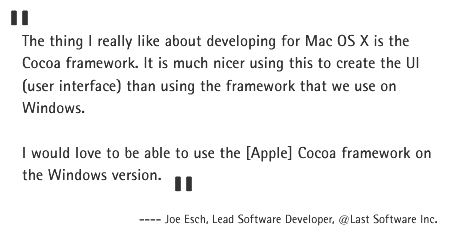|
<
| 1 | 2 | 3
| >
Joe: I
don't think that there was anything about the Apple
implementation of OpenGL that particularly impressed me.
One of the main points of using OpenGL is that it is a standard
API (application programming interface) that you can use on
different platforms. The fact that Apple had a good implementation
of OpenGL on OS X made it easier to decide to do the port.
They seem to have a solid implementation of it, but we don't
really use any of the extensions so there is nothing about
the Apple implementation that makes it especially compelling.
AFR.
What kinds of extensions has Apple made to OpenGL and if you
used them would you be able to implement them on Windows?
Joe: There
are lots of extensions to the OpenGL API. Some are created
by specific hardware vendors to take advantage of special
features on their boards. Others are defined by the OpenGL
Architectural Review Board. One nice thing that Apple
has done is that they have defined some extensions that are
supported across hardware, so you can program to the extensions
and run on both ATI and nVidia graphics boards.
Things are more complicated on the
Windows side. Microsoft pushes Direct3D, so they don't really
try to get vendors to support common OpenGL extensions. The
hardware vendors still offer lots of extensions, but it is
harder to take advantage of them without programming to specific
hardware.
We've considered using some of the
more common extensions to improve display performance, but
so far we've been sticking to pretty vanilla OpenGL to get
the best compatibility across a broad range of hardware.
AFR.
Is the Windows version of SketchUp also based on the OpenGL
API set or do you use Microsoft's proprietary technology?
Joe: We
use OpenGL in the Windows version also. Being able to use
the same graphics API was one of the things that helped when
we did the port.
AFR.
Did you choose OpenGL as your preferred 3D API because of
its technical merits or because you wanted SketchUp to be
portable to other OS's after you guys got established with
the Windows version?
Joe: Both
actually. I was already familiar with OpenGL, so that was
one consideration. I thought that it was a better choice technically
than [Microsoft] Direct3D -- which has been targeted primarily
at the game market. Also, we wanted the cross platform compatibility
in case we did decided to port to different platforms.

AFR.
So let's recap a bit. Apple's implementation of OpenGL is
solid but you aren't using any particular extra extensions
there. Are there any other developer things that Apple is
doing well...what about Apple's Quartz Extreme, are you planning
on using that?
Joe: We
don't directly take advantage of anything in Quartz
Extreme. The fact that it is built on OpenGL adds to our
confidence that Apple is committed to having a good implementation
of OpenGL.
As I said earlier, OpenGL is pretty
much OpenGL. The thing I really like about developing for
Mac OS X is the Cocoa
framework. It is much nicer using this to create the UI
(user interface) than using the framework that we use on Windows.
I would love to be able to use the Cocoa framework on the
Windows version.
AFR.
As a cross-platform developer would you prefer it if Cocoa
could target Windows in addition to the Mac?
Joe:
The core of SketchUp
is all written in portable C++. The GUI in the Windows version
is done using the MFC framework. When we decided to move to
the Mac, I spent some time looking at cross platform GUI toolkits.
I didn't really find anything that I liked though. One of
my main objectives was to make the Mac version look and feel
like a native Mac application rather than like a Windows application
that was ported to the Mac. In the end, I ended up using Cocoa
and Objective-C++.
It would be nice if we could target Windows using Cocoa.
It would be a hard decision to go back and redo the Windows
GUI using Cocoa at this point though.
AFR.
What is @Last Software's goal with the development of SketchUp?
Where is the product going to go and who would you say are
your competitors in the market?
Joe:
Our primary goal in creating SketchUp was to come
up with an application that would make 3D design and modeling
easy enough to learn and use that someone who was not an expert
in modeling could use it. We also wanted the modeling process
to be much more fluid so that you could quickly play around
with different design ideas.
There are a lot of other applications available that let
you do 3D modeling. We don't consider most of them as competitors
though. A lot of the other systems try to provide a complete
solution that lets you do everything with a single application.
With SketchUp, we don't try to do everything, but we try to
make what we do very easy to use.
AFR.
Why did SketchUp come to the architectural market? Are you
guys interested in architecture in particular or was this
decision based on some market research that said this area
was a void that could be filled in the market...that the architecture
market needed an ultra easy-to-use 3D program?
<
| 1 | 2 | 3
| >
|






![]()
![]()